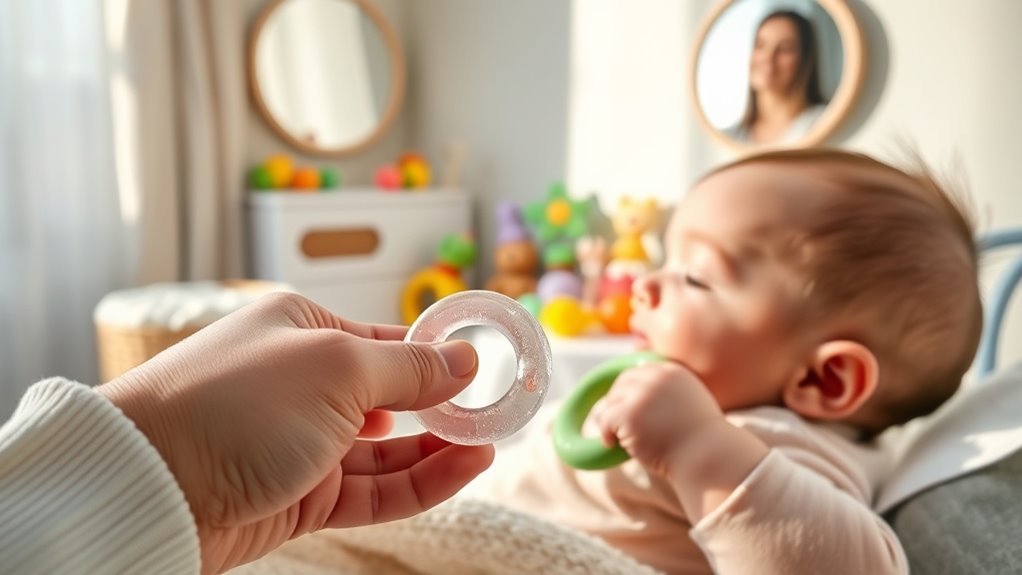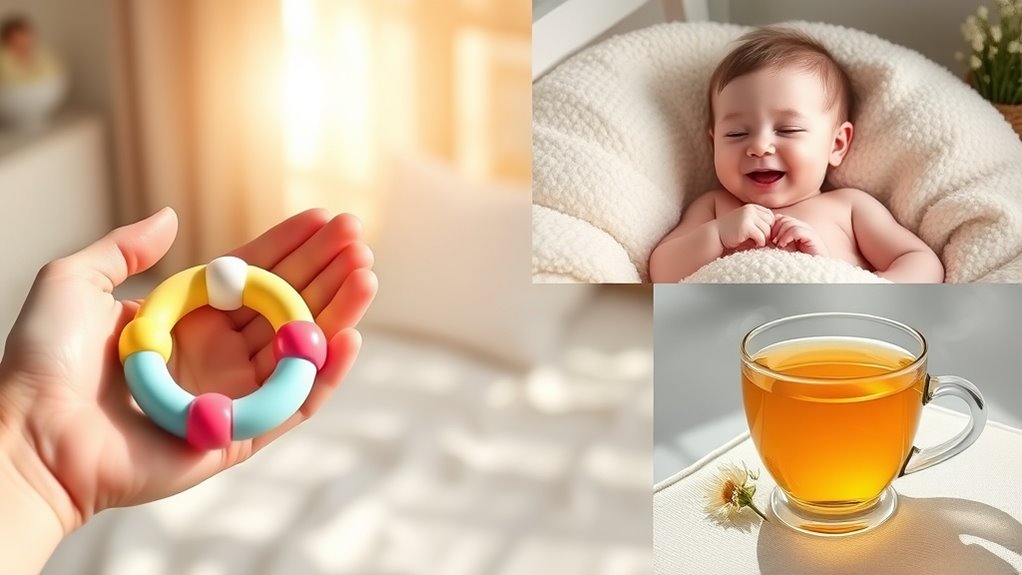To soothe your teething baby, start with cold therapy by using chilled teething rings or a wet washcloth. Next, massage their gums gently with clean fingers to ease discomfort. Lastly, offer soft foods like chilled pureed fruits, ensuring they stay hydrated. If discomfort persists, consider consulting with your pediatrician about safe medications. These steps can make a significant difference, and there’s more to explore about keeping your little one comfortable during this phase.
Key Takeaways
- Use cold therapy by providing chilled teething rings or a clean, wet washcloth to numb sore gums and reduce swelling.
- Gently massage your baby’s gums in a circular motion with clean fingers to alleviate discomfort and stimulate gum relief.
- Offer soft, chilled pureed fruits or vegetables to soothe irritated gums while ensuring proper hydration.
- Choose safe teething toys made of silicone or rubber, avoiding hard objects and liquid-filled toys that may pose choking hazards.
- Consult a pediatrician for appropriate medication options, such as acetaminophen or ibuprofen, if necessary for managing pain.

Teething can be a tough time for both you and your baby, but relief is possible in just three simple steps. First, understanding the symptoms of teething is crucial. Around six months of age, your little one may start experiencing gum swelling, tenderness, and excessive drooling, which can lead to irritability. Recognizing these signs can help you prepare for the discomfort that often accompanies this phase.
Teething can be challenging for both you and your baby, but recognizing the symptoms early can help ease their discomfort.
If symptoms persist or worsen, don’t hesitate to consult your pediatrician for professional guidance.
To ease your baby’s discomfort, cold therapy is a fantastic option. Chilled teething rings are a great choice; just pop them in the refrigerator, and they’ll numb those sore gums while reducing swelling. You can also use a clean, wet washcloth that you’ve chilled. Let your baby chew on this soothing fabric for relief. Additionally, a cool metal spoon can provide gentle gum relief when brushed against the gums.
Refrigerated pacifiers are another effective tool, providing a cool touch to sore gums. If you have a metal spoon, cool it down and gently brush your baby’s gums with it. Just remember, avoid frozen items as they can be too hard and may damage delicate gums.
Another step to consider is using safe teething toys and objects. Opt for silicone or rubber teething toys, as they’re easy to clean and safe for your baby. Stay away from liquid-filled teething rings, since they pose a choking hazard if they burst.
Hard objects can also harm your baby’s gums, so stick to soft, safe options. Always make sure to clean teething toys regularly to prevent any bacterial buildup.
Additionally, you can provide gentle gum massage and stimulation. Using a clean finger, gently rub your baby’s gums in a circular motion. This helps alleviate pain and discomfort. You can also let your baby chew on your clean finger, which adds another level of comfort.
Dietary adjustments can further aid in easing your baby’s teething pain. Offer them chilled pureed fruits or vegetables, and stick to soft foods that won’t irritate their gums. Keeping your baby hydrated is essential, so ensure they’re drinking enough fluids during this time.
Finally, if the pain seems severe, consult your pediatrician about medication options like acetaminophen or ibuprofen. Always follow their advice on dosage and avoid using benzocaine-containing products for children under two.
Frequently Asked Questions
What Are the Signs That My Baby Is Teething?
You might notice several signs that your baby is teething.
Look for increased drooling, which can lead to a rash on their face. Their gums may appear swollen and tender. You may see them chewing on objects to relieve discomfort, and they could become more irritable than usual.
A slight rise in body temperature is common, but remember that high fevers aren’t typical for teething. Monitoring these symptoms is essential to ensure they’re not due to another issue.
Can Teething Cause Fever or Diarrhea in Babies?
You might notice your baby has a slight fever or diarrhea during teething, but it’s likely just a coincidence.
Teething itself doesn’t cause true fevers or diarrhea; instead, infections or other issues might be at play. If your baby’s temperature goes above 100.4°F or diarrhea persists, it’s wise to consult a doctor.
Remember to monitor symptoms closely and keep your little one hydrated during this challenging time!
At What Age Do Babies Typically Start Teething?
Babies typically start teething around 6 months old, but some may begin as early as 2 to 3 months or even later than 12 months.
You’ll notice that every baby is different, and the timing can vary significantly.
As your little one grows, keep an eye out for signs like drooling or chewing on toys, which often indicate that they’re ready to start this new phase of development.
Are There Any Home Remedies for Teething Pain?
Yes, there are several home remedies you can try for teething pain.
You can offer your baby a chilled washcloth or a cold teething ring to soothe their gums. Gently massaging their gums with your finger can also help relieve discomfort.
Consider giving cool foods like yogurt or applesauce, and remember that a warm bath might help relax them.
Always keep an eye on their reactions to ensure they’re comfortable and safe.
Should I Consult a Doctor if Teething Seems Severe?
If you notice severe symptoms while your baby’s teething, it’s definitely a good idea to consult a doctor.
Symptoms like persistent crying, high fever, or facial swelling aren’t typical for teething and could indicate an underlying issue.
You shouldn’t ignore signs like gum bleeding or changes in appetite and sleep patterns.
It’s better to be safe and get a professional’s opinion to ensure your little one’s health isn’t at risk.
Conclusion
In the end, finding teething relief doesn’t have to be complicated. By following these three simple steps, you can soothe your little one’s discomfort and bring back those precious smiles. It’s funny how a bit of chilled fruit or a gentle massage can make such a difference, right? Just when you think you’re out of options, a little creativity and care can turn things around. So go ahead, embrace these moments—they’ll be gone before you know it!









